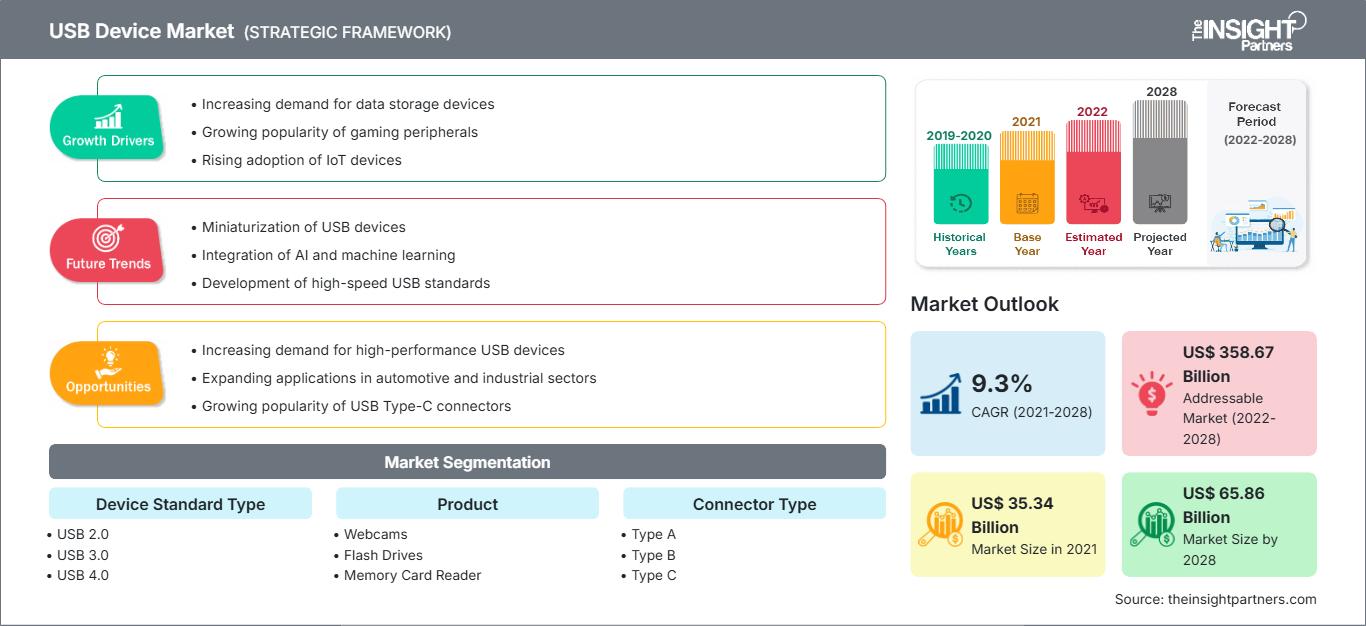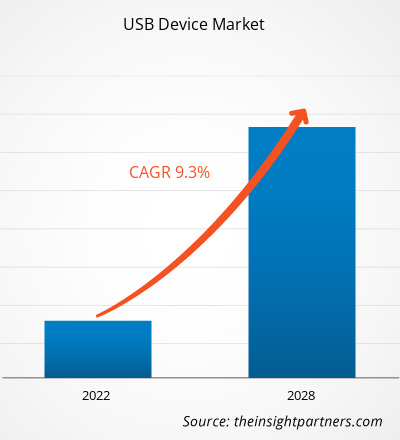Der Markt für USB-Geräte wurde im Jahr 2021 auf 35.339,3 Millionen US-Dollar geschätzt und soll bis 2028 65.857,2 Millionen US-Dollar erreichen; von 2021 bis 2028 wird eine durchschnittliche jährliche Wachstumsrate (CAGR) von 9,3 % erwartet.
Die zunehmende Nutzung von Unterhaltungselektronik wie Smartphones und Laptops in Industrie- und Entwicklungsländern ist hauptsächlich auf steigendes verfügbares Einkommen, Bevölkerungswachstum und eine zunehmende Internetdurchdringung zurückzuführen. Die anhaltenden bedeutenden technologischen Entwicklungen haben zu einer zunehmenden Verbreitung dieser Geräte in mehreren Volkswirtschaften geführt. Im Jahr 2020 wurden in den USA laut der Consumer Technology Association (CTA) 152 Millionen Smartphones verkauft. USB-Geräte sind zu einer dominierenden Schnittstelle geworden, um den wachsenden Anforderungen an eine schnelle Datenübertragung zwischen Endgeräten wie Laptops, Smartphones, PCs und Digitalkameras gerecht zu werden. Angesichts der steigenden Nachfrage nach Unterhaltungselektronik und Datenübertragungsprodukten konzentrieren sich die Akteure auf dem globalen Markt für USB-Geräte auf die Einführung neuer Produkte, um nachhaltiges Wachstum zu erzielen, sich von der Konkurrenz abzuheben und so zum Marktwachstum beizutragen.
Passen Sie diesen Bericht Ihren Anforderungen an
Sie erhalten kostenlos Anpassungen an jedem Bericht, einschließlich Teilen dieses Berichts oder einer Analyse auf Länderebene, eines Excel-Datenpakets sowie tolle Angebote und Rabatte für Start-ups und Universitäten.
USB-Gerätemarkt: Strategische Einblicke

-
Holen Sie sich die wichtigsten Markttrends aus diesem Bericht.Dieses KOSTENLOSE Beispiel umfasst Datenanalysen, die von Markttrends bis hin zu Schätzungen und Prognosen reichen.
Auswirkungen der COVID-19-Pandemie auf den Markt für USB-Geräte
COVID-19 behinderte die weltweite Einführung von USB-Geräten im Jahr 2020, da die Verkäufe in Branchen wie der Elektronik- und Automobilindustrie aufgrund der Auswirkungen auf die Lieferketten behindert wurden. Gleichzeitig wurde in den Bereichen IT & Telekommunikation und Gesundheitswesen ein höherer Einsatz von USB-Geräten gemeldet, da nach einem Anstieg der Patientenzahlen in Krankenhäusern aufgrund von COVID-19 großer Wert auf Telearbeit und Fernunterricht gelegt wurde. Ab dem ersten Quartal 2021 begannen sich die Lieferketten der Automobil- und Elektronikindustrie jedoch zu stabilisieren, und die Umsätze dieser Branchen zeigten eine positive Dynamik, die anschließend den Markt für USB-Geräte vorantrieb.
Markteinblicke – Markt für USB-Geräte
USB Typ-C nimmt in der Medizinbranche stark zu
Die technologischen Fortschritte bei USB Typ-C werden dessen Bedeutung in der Medizinbranche voraussichtlich steigern. Namhafte Unternehmen entwickeln intensiv USB-Geräte der nächsten Generation, um in diesem hart umkämpften Markt die Nase vorn zu behalten. TE Connectivity hat beispielsweise seinen integrierten USB Typ-C-Buchsenstecker auf den Markt gebracht. Dabei handelt es sich um ein wasserdichtes Gerät, das Systeme in rauen Umgebungen mit IPX8 (Wasserdichtigkeit) vor Staub und Wasser schützt. Dank der Wasserdichtigkeit hält der USB Typ-C-Stecker in einer Wassertiefe von 1,5 m mindestens 30 Minuten lang eine kontinuierliche Verbindung aufrecht. Die zunehmende Alterung der Bevölkerung und der steigende Bedarf an Frühdiagnosen chronischer Krankheiten steigern zudem die Nachfrage nach medizinischen Bildgebungsgeräten weltweit und damit auch nach USB Typ-C-Geräten der nächsten Generation. Daher wird ein solcher Anstieg der Verwendung von USB-Typ-C-Systemen, insbesondere in der Medizingeräteindustrie, den Akteuren auf dem USB-Gerätemarkt in den kommenden Jahren voraussichtlich Wachstumschancen bieten.
Anwendungsbasierte Erkenntnisse
Basierend auf dem Typ ist der USB-Gerätemarkt in Unterhaltungselektronik, Automobil, IT & Telekommunikation sowie Gesundheits- und Medizingeräte segmentiert. Das Segment IT & Telekommunikation wird 2021 voraussichtlich den größten Marktanteil halten.
Die Akteure auf dem USB-Gerätemarkt konzentrieren sich hauptsächlich auf die Entwicklung fortschrittlicher und effizienter Produkte.
- Im Oktober 2021 kündigte SK hynix Inc. die Einführung des ersten DDR5-DRAM an. Es handelt sich um ein Hochgeschwindigkeits- und Hochdichteprodukt, das als DRAM-Standard der nächsten Generation für Big Data, künstliche Intelligenz (KI) und maschinelles Lernen (ML) optimiert ist.
- Im August 2021 gab Analog Devices, Inc. die Übernahme von Maxim Integrated Products, Inc. bekannt. Der Zusammenschluss stärkt die Position von ADI als leistungsstarkes analoges Halbleiterunternehmen mit einem Umsatz von über 9 Milliarden US-Dollar in den letzten 12 Monaten, branchenführenden Margen und einem freien Cashflow von über 3 Milliarden US-Dollar auf Pro-forma-Basis weiter.
Der USB-Gerätemarkt ist nach Gerätestandardtyp, Produkt, Anschlusstyp, Anwendung und Geografie segmentiert. Basierend auf dem Gerätestandardtyp ist der Markt in USB 2.0, USB 3.0 und USB 4.0 segmentiert. Im Jahr 2021 wird das USB 3.0-Segment voraussichtlich den größten Marktanteil halten. Der Markt für USB-Geräte ist je nach Produkt in Webcams, Flash-Laufwerke, Speicherkartenleser, digitale Audioplayer, Computerperipheriegeräte und weitere unterteilt. Im Jahr 2021 dürfte das Segment Computerperipheriegeräte den größten Marktanteil halten. Nach Anschlusstyp ist der Markt für USB-Geräte in Typ A, Typ B, Typ C und Lightning-Anschluss unterteilt. Im Jahr 2021 dürfte das Typ-B-Segment den größten Marktanteil halten. Nach Anwendung ist der Markt in Unterhaltungselektronik, IT und Telekommunikation, Automobilindustrie, Gesundheitswesen und Medizintechnik und weitere unterteilt. Im Jahr 2021 dürfte das Segment IT und Telekommunikation den größten Marktanteil halten. Geografisch ist der Markt grob in Nordamerika, Europa, den asiatisch-pazifischen Raum (APAC), den Nahen Osten und Afrika (MEA) und Südamerika (SAM) unterteilt. Im Jahr 2021 hatte Nordamerika einen erheblichen Anteil am Weltmarkt.
USB-Gerätemarkt
USB-GerätemarktDie Analysten von The Insight Partners haben die regionalen Trends und Faktoren, die den USB-Gerätemarkt im Prognosezeitraum beeinflussen, ausführlich erläutert. In diesem Abschnitt werden auch die Marktsegmente und die geografische Lage von USB-Geräten in Nordamerika, Europa, dem asiatisch-pazifischen Raum, dem Nahen Osten und Afrika sowie Süd- und Mittelamerika erörtert.Umfang des Marktberichts zum USB-Gerätemarkt
| Berichtsattribut | Einzelheiten |
|---|---|
| Marktgröße in 2021 | US$ 35.34 Billion |
| Marktgröße nach 2028 | US$ 65.86 Billion |
| Globale CAGR (2021 - 2028) | 9.3% |
| Historische Daten | 2019-2020 |
| Prognosezeitraum | 2022-2028 |
| Abgedeckte Segmente |
By Gerätestandardtyp
|
| Abgedeckte Regionen und Länder |
Nordamerika
|
| Marktführer und wichtige Unternehmensprofile |
|
Dichte der Marktteilnehmer für USB-Geräte: Auswirkungen auf die Geschäftsdynamik verstehen
Der Markt für USB-Geräte wächst rasant. Die steigende Nachfrage der Endnutzer ist auf Faktoren wie veränderte Verbraucherpräferenzen, technologische Fortschritte und ein stärkeres Bewusstsein für die Produktvorteile zurückzuführen. Mit der steigenden Nachfrage erweitern Unternehmen ihr Angebot, entwickeln Innovationen, um den Bedürfnissen der Verbraucher gerecht zu werden, und nutzen neue Trends, was das Marktwachstum weiter ankurbelt.

- Holen Sie sich die USB-Gerätemarkt Übersicht der wichtigsten Akteure
Markt für USB-Geräte – Unternehmensprofile
- ADATA Technology Co., LtdInc.Unternehmen
- Microchip Technologies, Inc
- Maxim Integrated
- Historische Analyse (2 Jahre), Basisjahr, Prognose (7 Jahre) mit CAGR
- PEST- und SWOT-Analyse
- Marktgröße Wert/Volumen – Global, Regional, Land
- Branchen- und Wettbewerbslandschaft
- Excel-Datensatz
Aktuelle Berichte
Erfahrungsberichte
Grund zum Kauf
- Fundierte Entscheidungsfindung
- Marktdynamik verstehen
- Wettbewerbsanalyse
- Kundeneinblicke
- Marktprognosen
- Risikominimierung
- Strategische Planung
- Investitionsbegründung
- Identifizierung neuer Märkte
- Verbesserung von Marketingstrategien
- Steigerung der Betriebseffizienz
- Anpassung an regulatorische Trends






















 Kostenlose Probe anfordern für - USB-Gerätemarkt
Kostenlose Probe anfordern für - USB-Gerätemarkt